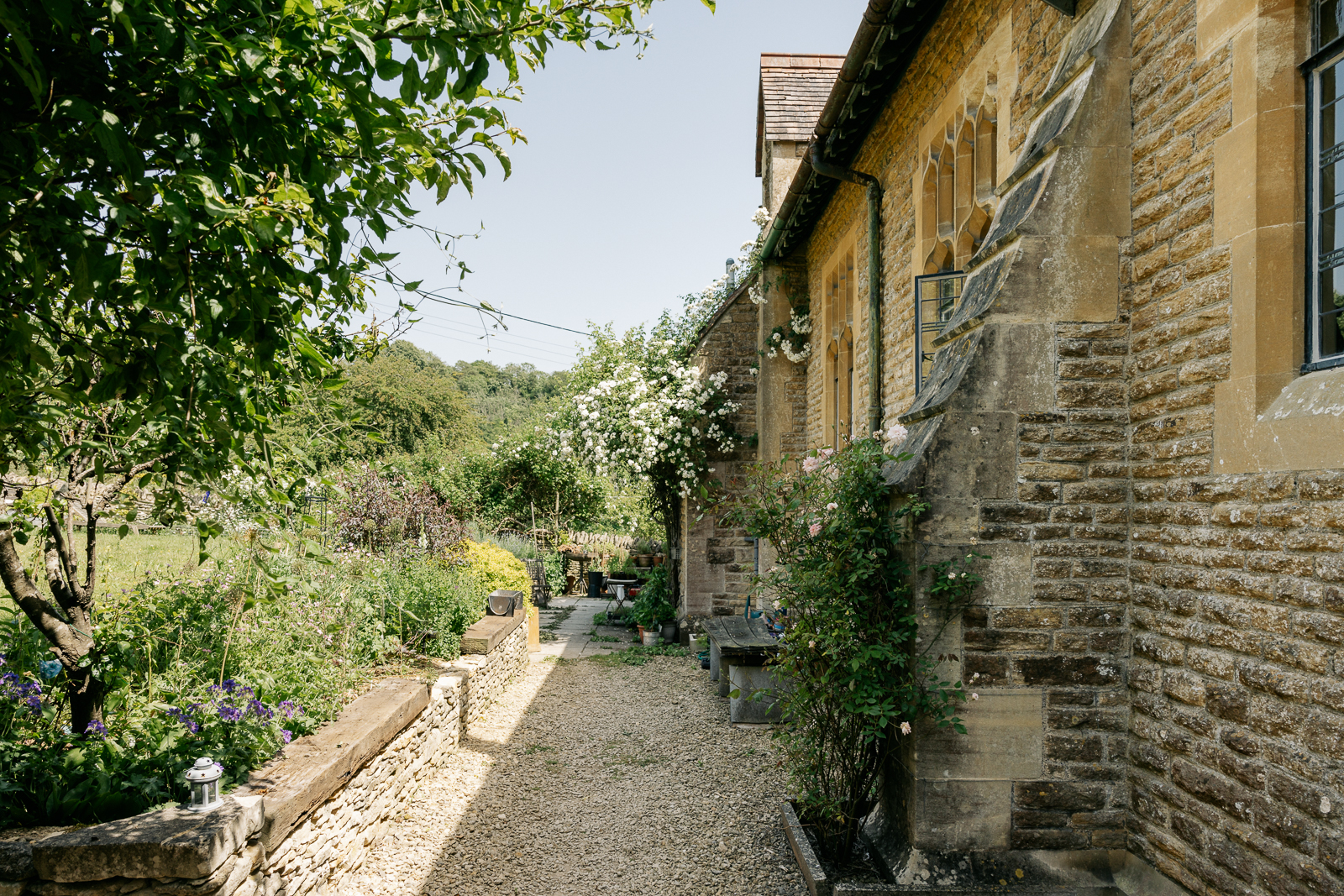Old St John’s is set back from the road, moments from the River Bybrook and nestled between neighboring fields. A kissing gate and a commanding porch lead to a set of Gothic arched front doors and an entrance hallway.
In the hallway, a contemporary stairway is bathed in light from a vast window with perpendicular tracery and stone mullions. An original Victorian Charles Portway ‘Tortoise’ stove sits in the hall and is still used to heat the house. A long corridor runs the length of the church and leads to the bedrooms and entertaining spaces. Pitch pine floorboards are found throughout the building.
A striking kitchen occupies the old chancel and is fitted with terracotta tiles and appliances by
Liebherr and
Aga. At the end of the soaring, double-height space sits the room’s focal point: an extraordinary Grade II*-listed stained-glass window with panel by Edward Burne-Jones. A rood screen is alleged to have been supplied by William Morris’s company; both the windows and the screen have decorative tracery, carved head stops, and mouldings. The screen has been cleverly glazed, dividing the room while keeping the volume of the spaces intact. A spiral staircase leads to what was the organ loft, now a study space and reading nook.
The first floor is accessed by a curved staircase. From here, the arresting intricacy of the barrel-vaulted ceilings can be seen up close; each of the hand-carved bosses has been individually designed. The vast yet comfortable space, with a wood-burning stove and dual-aspect views, is perfect for entertaining. Through the main living space, there is a gym/study, which would also make a good bedroom. From here, it is possible to access the bell tower with its working church bell.
On the ground floor, the original vestry has been converted into a charming snug/bedroom with a wood-burning stove. Three additional bedrooms overlook the private back garden and feel quiet and secluded. An en suite adjoins the largest of the three bedrooms, while a further family bathroom and smaller shower room lead off the main hall.
The Great Outdoors
The extensive garden sits at the back of the plot and is surrounded by bucolic pasture. Predominantly lawn, the current owners have created intimate patio spaces for entertaining or outdoor dining. A thicket surrounds the plot, leading to its sense of privacy and seclusion, and wildflowers grow in the adjoining beds.
A private side driveway is accessed via arched oak posts and a gate; this leads to a large gravel driveway and a side dormer entrance, which houses a spacious utility room.
Beyond the garden hedge, there is a secondary plot of land that is home to an existing building in need of repair, which has lapsed planning consent for an ancillary building.
Out and About
One of four small villages and hamlets that surround North Wraxall Parish, Wiltshire, Ford has a wonderfully active local community. The house is close to a good selection of both private and state, primary and secondary schools.
The Georgian splendour of Bath is a 20-minute drive from the house. The city’s cultural distractions are plentiful and include The
Holburne Museum, the
Fashion Museum and
The Edge, as well as two brilliant art-house cinemas and
The Royal Theatre. The Grade II* listed
Cleveland Pools – designed in 1815 by the same architect responsible for Daniel Street and believed to be England’s oldest public outdoor swimming pool – is also a popular spot. Other options to while away an afternoon include
Bath Recreation Ground, the National Trust’s
Skyline Walk and the
Roman Baths.
A 25-minute drive from Old St John’s, Bradford-on-Avon is a charming Saxon town, with graceful architecture akin to its Georgian neighbour, Bath. The town centre has a thriving local community of independent shops, cafes and eateries in what is one of the UK’s most attractive small towns (it was described in
The Guardian’s ‘Let’s Move To…’ column as “the loveliest town in the whole country”.)
The Bunch of Grapes, a well renowned pub and restaurant which was named as one of the best places in the country for Sunday lunch in the Observer Food Monthly awards.
Timbrell’s Yard, situated on the riverside, is popular amongst local residents.
The popular Cotswold towns and villages of Tetbury and Malmesbury are a 30-minute drive away. For day-to-day convenience, Malmesbury Waitrose is approximately 20 minutes from the house by car.
Chippenham’s train station is around 12 minutes’ drive away, with journeys to London Paddington taking 70 minutes on the fast and direct mainline, calling at only three other stations.
Council Tax Band: F


